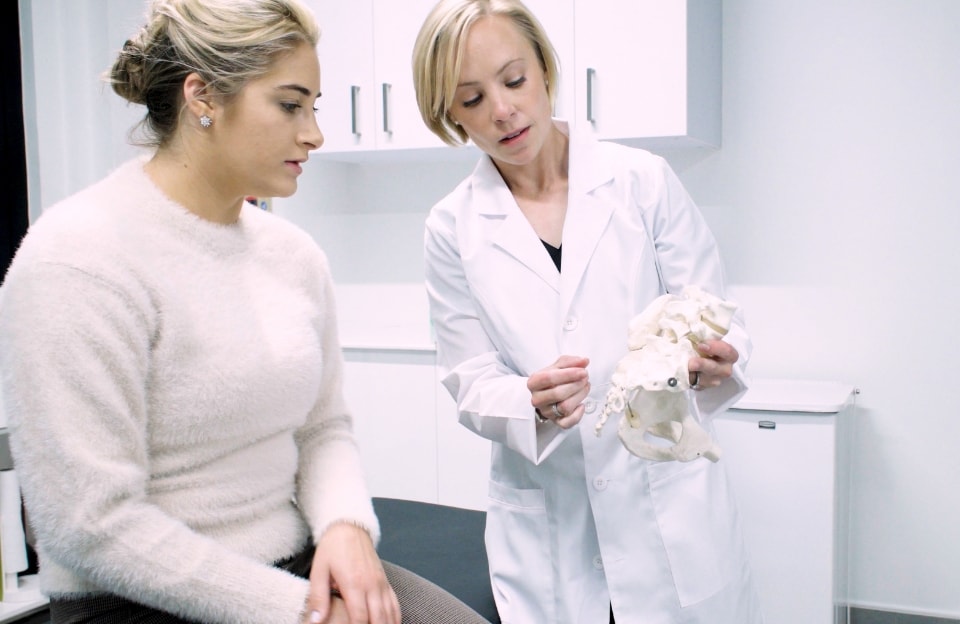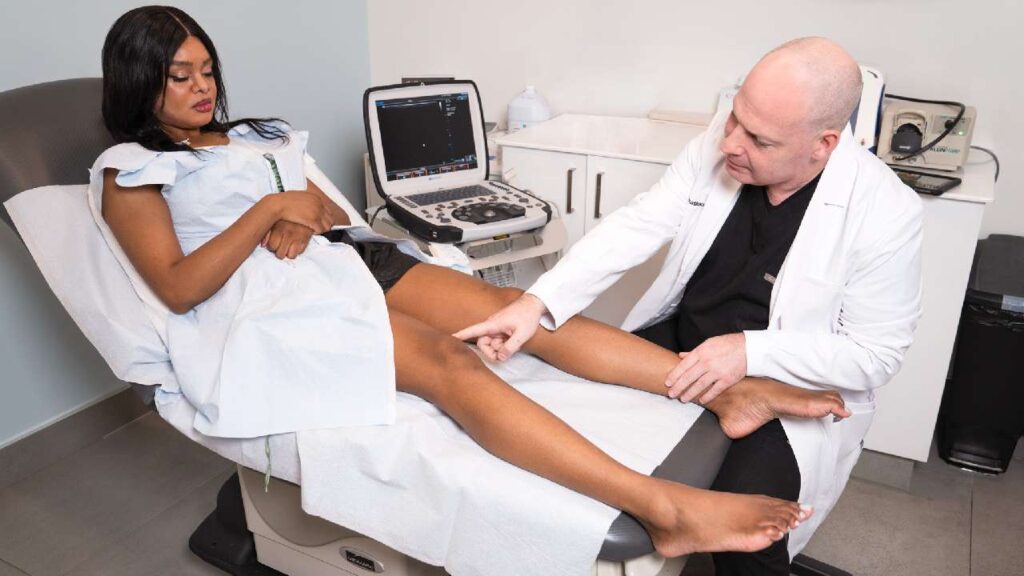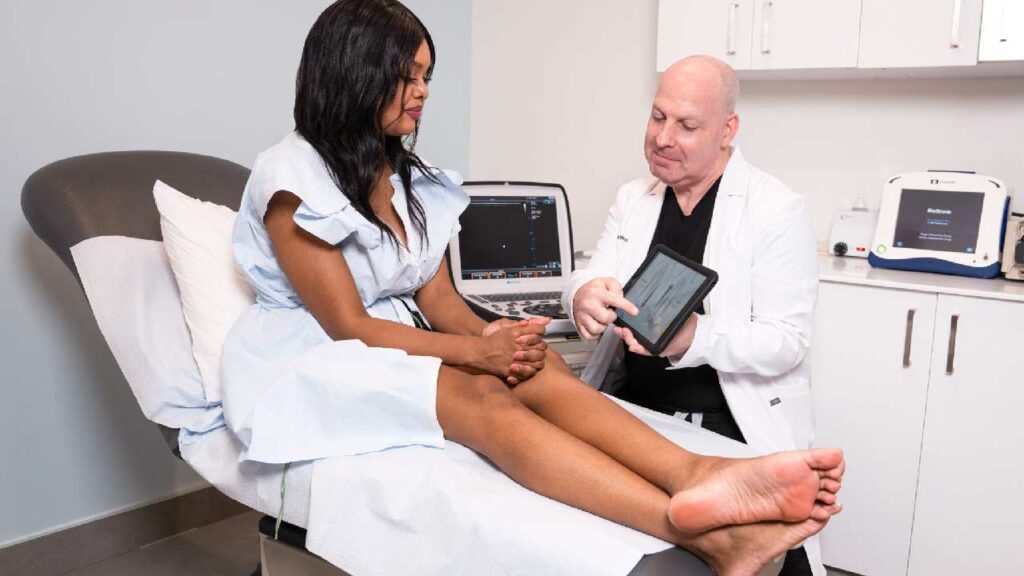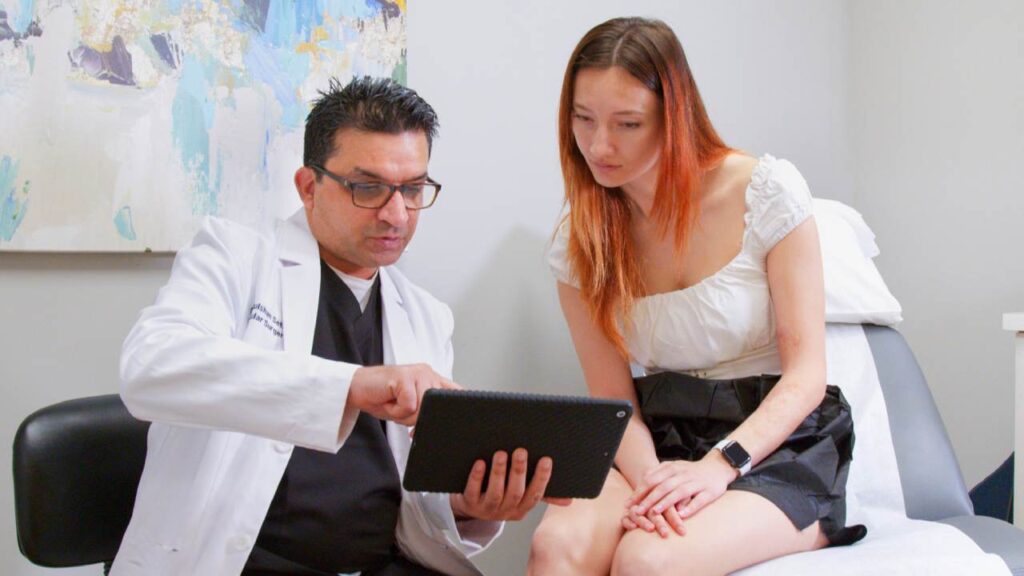What Exactly Is Laser for Spider Veins?
Lasers are used in various ways to treat spider veins. One way is by applying lasers to the surface of the skin to heat the damaged vein. The laser transmits photons that are absorbed by the blood, which generates thermal energy. By heating the vein, it shrinks and dissolves over time. This method is primarily used for facial spider veins that are quite small and close to the surface of the skin.

Another method is endovenous laser therapy, in which a tiny needle is inserted into the skin and lasers are aimed directly at the vein wall. This works better for larger, deeper veins, and for spider veins in the legs rather than the face. Both laser methods have some pros and cons, and there are alternatives that might work better for you, namely sclerotherapy, if your spider veins are in your legs. Click HERE to talk to our doctors about choosing sclerotherapy or laser for spider veins.
Is Laser Better Than Spider Vein Removal with Sclerotherapy?
Topical laser treatment is typically only successful with small, sparse, facial spider veins, not spider veins in the legs. Leg veins are often a bit deeper in the skin and also larger than the veins on the face. In order to treat deeper veins with topical lasers, the amount of thermal energy required would pose a risk to the surrounding tissue and the skin at the treated area. Laser treatment can cause pain, swelling, crusting, bleeding, discoloration, infection, or scarring, particularly if it exceeds the recommended amount of heat. In fact, depending on your skin type, you might not be eligible for laser treatment. So, for leg veins, our NY vein doctors do not typically recommend topical light therapy.
Endovenous laser therapy is sometimes recommended for spider veins in the legs. In this procedure, the vein doctor inserts a needle that allows them to reach deeper and larger veins and aim lasers at the blood vessel, reducing the risk of skin irritation and the degree of heat required for treatment through the skin. For this to be safe and successful, doctors will surround the vein with tumescent anesthesia to provide a buffer against the heat and to help the vein collapse around the treatment device. While this works better for spider veins in the legs than light therapy through the skin, it is not our method of choice for spider veins. Read on to learn why.
Is Laser or Sclerotherapy Best for Broken Capillaries on Legs?
Sclerotherapy is recommended over surface laser treatment for broken capillaries on legs, largely because of their size, depth, and proliferation. Spider veins in the legs often form in clusters, rather than the single threads that sometimes appear on the face, so there are multiple branches to treat. Injecting the problematic vein with a sclerosing agent allows vein doctors to treat multiple pathways at once.
Endovenous laser treatment is better than surface lasers for most leg veins. However, since it uses thermal energy, pain and swelling after vein ablation with lasers is more common than with sclerotherapy. EVLA also requires an anesthetic that some patients are sensitive to. If you aren’t a good candidate for sclerotherapy, our NY vein doctors typically recommend radiofrequency ablation over endovenous laser ablation. Radiofrequency does not get as hot as lasers, and it’s more comfortable for our patients.
Is Laser Both a Varicose Veins & Spider Veins Treatment?
Surface laser treatments are not effective against most varicose veins. Varicose veins are twisted, thick veins that are harder to fully treat from the surface of the skin. Furthermore, since they are often quite large in comparison to spider veins, laser heat is not advised in order to protect the skin. Varicose veins are also highly indicative of a common disease called Chronic Venous Insufficiency. This condition requires vein doctors to treat valve failure in deeper veins that’s causing varicose veins to develop. This cannot be done at the skin’s surface. Endovenous lasers might be used as treatment for varicose veins, but our vein specialists prefer radiofrequency over lasers for the lower heat and more successful outcome.
Laser vs. Sclerotherapy: What Can Get Rid of Varicose Veins?
If you have varicose veins, along with spider veins, talk to our Harvard-trained vein doctors about how we treat both efficiently. Surface lasers are only a temporary fix if you have underlying vein disease, which is a strong possibility if you have both spider veins and varicose veins. We use innovative tools like ClariVein, which treats the vein both chemically and mechanically for a thorough resolution, in addition to vein adhesives like VenaSeal, and stronger foam concentrations of sclerotherapy like Varithena and radiofrequency treatments like VNUS Closure. If you’re wondering what can get rid of varicose veins or spider veins permanently, visit our NY vein clinic for the best treatments.
Is Laser a Vascular Surgery or Varicose Veins Treatment?
No, laser isn’t a vascular surgery in the traditional sense. It does not require large incisions, stitches, general anesthesia, or hospitalization. Lasers are one of several minimally invasive procedures that now prevent surgery, for most patients. Laser treatment is quick and outpatient, requiring only a few minutes in the doctor’s office. Post varicose vein surgery care is more involved than caring for minimally invasive procedures like laser therapy.
With minimally invasive methods, the most that’s required is wearing compression stockings for a short period of time, for some patients. Surgery requires a recovery and healing period, while lasers and radiofrequency allow you to resume all normal activities. Surgical varicose vein removal, before and after the procedure, requires steps that aren’t required for minimally invasive treatments, since surgery extracts the vein from the body, whereas lasers heat veins within the body.
And no, surface lasers are not the most recommended varicose veins treatment. For the reasons we mentioned above, including the size, depth, and likelihood of Chronic Venous Insufficiency associated with varicose veins, our NY vein treatment clinic recommends Varithena, ClariVein, VNUS Closure, and other alternatives for varicose veins. For spider veins, we primarily recommend sclerotherapy.
Does Laser Prevent New Veins Popping Out on Legs?
Surface laser treatment will not impact new veins popping out on the legs. Both varicose veins and spider veins are often caused by Chronic Venous Insufficiency, especially when they’re found in the legs. Leg veins must bear your body weight and resist gravity to pump blood back up to your heart. As such, they’re more prone to valve failure and excess pressure, which means spider veins in the legs aren’t usually caused by sun damage and the things that cause facial spider veins. Topical lasers don’t address that vein disease, so new spider veins and varicose veins will continue to appear. Endovenous lasers can treat Chronic Venous Insufficiency, but for many patients, radiofrequency, vein adhesives, or sclerosants are better options.
Which NY Leg Vein Clinic Offers Laser or Sclerotherapy?
If you’re seeking treatment for spider veins, particularly for veins in the legs, you need to choose a board certified vein doctor at a medical clinic. Estheticians, beauty spas, and dermatologists typically only offer surface laser treatment. These treatments aren’t successful against most leg veins, and the results are only temporary if you have Chronic Venous Insufficiency.
Our award-winning NY vein clinic offers a comprehensive array of treatment options, and also customizes treatment, combining methods if needed for best results. To treat vein damage permanently and prevent complications of vein disease, choose a doctor who studied venous medicine and the vascular system, rather than skin. Visit our esteemed NY vein experts today for immaculate results!





